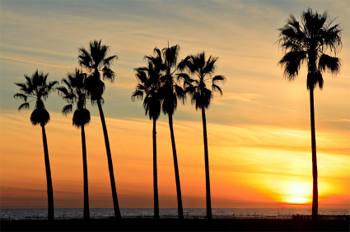May 14, 2007
Second Thoughts About Palm Trees

By Michael D. Shaw
In Los Angeles, a city famous for its landmarks, members of the City Council have decided to forgo one icon that is neither affordable nor environmentally sound, namely the continued planting of palm trees—those tall semitropical symbols of wealth, leisure, prestige, and all the other sundry images people have of the City of Angels. A municipal measure passed in November, 2006 limits future use of palms along city streets unless they are needed to be consistent with existing plantings, or are specifically requested by a council office or community group.
Despite their iconic status in LA, palm trees are not even native to Southern California, having been imported to the region by Catholic missionaries centuries ago. Over time, the trees have become increasingly troublesome, requiring expensive maintenance and providing few if any benefits for residents. Problems worsen during the summer, particularly in downtown Los Angeles, when people seek refuge from the heat and search in vain for a tall tree with abundant shade.
Councilwoman Janice Hahn, who wrote the measure, noted that LA’s move away from palm trees was spurred in part by a public works analysis of satellite imagery suggesting that only 17% of Los Angeles is covered by a tree canopy. The average American city has 28% shade coverage.
This would explain why the heat index for Los Angeles is the worst for any big city in the United States. Add to that the growing threat of disease, and continuing business as usual with palm trees is simply a bad idea. For the past several years, the fusarium wilt, a widespread local fungus, has been systematically killing them, especially the Canary Island date palm.
Ironically, the fungus can be spread by the very maintenance required by the palms. It is often spread among trees by contaminated chain saws used by tree-trimmers to remove dead fronds.
Bear in mind that Los Angeles has an arid, desert-like climate where drought is a regular occurrence. Even though many equate palm trees with desert landscapes, they do best under oasis conditions! On the other hand, native species of live oak and sycamore can grow in these conditions without watering.
As to reducing air pollution, according to studies supervised by the US Forest Service, palm trees make poor street trees owing to low carbon and ozone absorption—a direct consequence of the low leaf area per plant. In contrast, coast live oak takes up 17 times more ozone, and 14 times more carbon than palm.
Even in Miami, a city that rivals—if not exceeds—LA’s obsession with palm trees, the royal palms that have lined the streets for decades are going away. Some residents say the palm trees are not only ugly but also dangerous, threatening passing cars when they shed their cumbersome fronds. A study in 1996 found that only about 10 percent of Miami-Dade County was covered by tree canopy—and that was before a disease known as citrus canker and recent hurricanes wiped out hundreds of thousands of shade trees.
Developers felled countless shade trees as Miami became a resort town and planted inexpensive types of palms, that could be plunked full grown in front of hotels and condominiums, screaming “paradise”—willy-nilly.
Listen to Steve Stern, owner of a nursery called Exotic Palms in Homestead, Florida:
“They want trees that are cheap, easy to carry around and grow fast.” Other trees do not provide immediate gratification.”
And therein lies the problem: A fixation with image over practicality, to say nothing of what’s good for the environment. What a surprise.
Miami mayor Manny Diaz has started a “canopy campaign” to plant shade trees in places that are barren or are currently overloaded with palms. Alyce Robertson, director of Miami-Dade County’s community image office says:
“If you come here as a tourist in January you certainly want to see palm trees,” she said. “But in July in South Florida, you don’t want to stand under a palm tree. Let’s have a balance here, folks.”
We should praise the civic action to de-emphasize eye candy palm trees. While they are doubtless iconic and popular among people’s perceptions of Los Angeles or Miami, palm trees are more suitable for truly exotic locales, not major cities.

